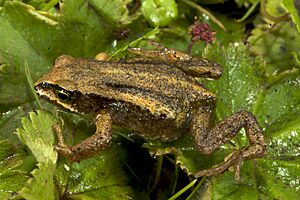Malcolm's Ethiopian toad facts for kids
Quick facts for kids Malcolm's Ethiopian toad |
|
|---|---|
| Conservation status | |
| Scientific classification |
The Malcolm's Ethiopian toad (Altiphrynoides malcolmi) is a special kind of toad. It's also called the Ethiopian mountain toad. This small toad lives only in the Bale Mountains of Ethiopia. It likes cool, wet places like mountain forests and open, grassy moorlands. Sadly, this toad is in danger. The IUCN (a big group that tracks animals) says it is an "endangered species" because it's losing its home.
Contents
What Does It Look Like?
Malcolm's Ethiopian toad is a small, strong toad. Female toads can grow up to 32 mm (1.3 in) long. Males are a bit smaller, reaching about 21 mm (0.8 in). Its head is wide, and its upper jaw is longer than its lower one.
The toad's skin color can be different shades. Some are greenish-grey, grey, greyish-brown, or even black. They often have dark spots. These spots are usually in three lines on top of a lighter color, like pink, dull red, or green. Their sides are grey or black. The belly is usually cream or dull white with darker spots.
Where Does It Live?
This unique toad lives only in the Bale Mountains in Ethiopia. You can find it high up in the mountains. It lives at heights between 3,200 and 4,000 metres (10,500 and 13,100 ft) above sea level.
Lower down, it lives in grassy areas near streams. Higher up, on the mountain tops, it lives in forests. These forests have special trees like Astropanax, Hagenia, and Hypericum. It also lives in open, grassy afromontane moorlands.
Life Cycle and Reproduction
Malcolm's Ethiopian toad has a very unusual way of growing up. Male toads make quiet calls to attract females. You can only hear these calls if you are very close.
Males and females walk through wet grass near streams. When they meet, the male calls louder. Other males then come to the spot. Many males compete to mate with one female.
The female lays about twenty large eggs. These eggs are covered in a slimy layer. This happens while the male and female are still together. The eggs are placed in plants, under logs, or in leaf litter. The female then leaves. The males stay and keep calling to attract more females. Many females might lay their eggs in the same spot. This can create a large egg mass from up to twenty females. The males leave once no more females arrive.
The parents do not care for the eggs after they are laid. The eggs have a large yolk sac inside. This yolk feeds the tadpoles as they grow. In a lab, eggs hatched in eleven days. In the wild, it might take longer because it's colder. When the tadpoles hatch, their tails are already shrinking. They finish changing into tiny toads soon after hatching.
Why Is It Endangered?
Even though Malcolm's Ethiopian toad is common in some places, its numbers are going down. The biggest problem for these toads is that their home is being destroyed. People are cutting down trees and letting more cattle graze. New settlements are also being built.
Part of the toad's home is inside the Bale Mountains National Park. This park helps protect the toads from some human activities. However, a fungus that causes a disease called chytridiomycosis has been found in these toads. This disease is a big threat to amphibians worldwide. Because of these reasons, the International Union for Conservation of Nature (IUCN) has listed this toad as an "endangered species".



